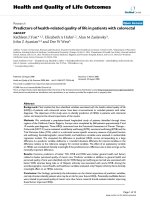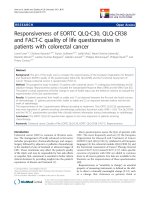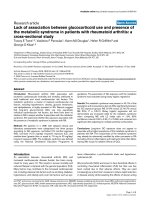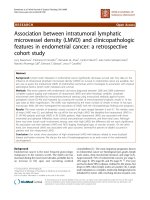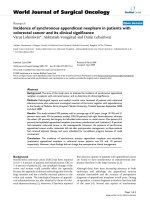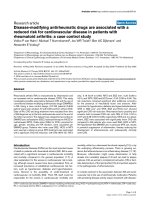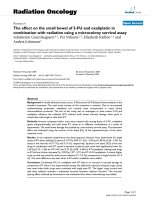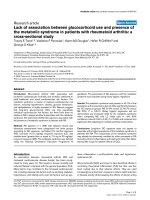Effect of diagnostic delay on survival in patients with colorectal cancer: A retrospective cohort study
Bạn đang xem bản rút gọn của tài liệu. Xem và tải ngay bản đầy đủ của tài liệu tại đây (758.55 KB, 11 trang )
Pita-Fernández et al. BMC Cancer (2016) 16:664
DOI 10.1186/s12885-016-2717-z
RESEARCH ARTICLE
Open Access
Effect of diagnostic delay on survival
in patients with colorectal cancer:
a retrospective cohort study
Salvador Pita-Fernández1*, Luis González-Sáez2, Beatriz López-Calviño1, Teresa Seoane-Pillado1,
Elena Rodríguez-Camacho3, Alejandro Pazos-Sierra4, Paloma González-Santamaría5 and Sonia Pértega-Díaz1
Abstract
Background: Disparate and contradictory results make studies necessary to investigate in more depth the relationship
between diagnostic delay and survival in colorectal cancer (CRC) patients. The aim of this study is to analyse the
relationship between the interval from first symptom to diagnosis (SDI) and survival in CRC.
Methods: Retrospective study of n = 942 CRC patients. SDI was calculated as the time from the diagnosis of
cancer and the first symptoms of CRC.
Cox regression was used to estimate five-year mortality hazard ratios as a function of SDI, adjusting for age and
gender. SDI was modelled according to SDI quartiles and as a continuous variable using penalized splines.
Results: Median SDI was 3.4 months. SDI was not associated with stage at diagnosis (Stage I = 3.6 months, Stage
II-III = 3.4, Stage IV = 3.2; p = 0.728). Shorter SDIs corresponded to patients with abdominal pain (2.8 months), and
longer SDIs to patients with muchorrhage (5.2 months) and rectal tenesmus (4.4 months).
Adjusting for age and gender, in rectum cancers, patients within the first SDI quartile had lower survival (p = 0.
003), while in colon cancer no significant differences were found (p = 0.282). These results do not change after
adjusting for TNM stage.
The splines regression analysis revealed that, for rectum cancer, 5-year mortality progressively increases for SDIs
lower than the median (3.7 months) and decreases as the delay increases until approximately 8 months. In colon
cancer, no significant relationship was found between SDI and survival.
Conclusions: Short diagnostic intervals are significantly associated with higher mortality in rectal but not in
colon cancers, even though a borderline significant effect is also observed in colon cancer. Longer diagnostic
intervals seemed not to be associated with poorer survival. Other factors than diagnostic delay should be taken
into account to explain this “waiting-time paradox”.
Keywords: Colorectal neoplasms, Delayed diagnosis, Survival, Mortality, Statistics, Nonparametric
Abbreviations: CRC, Colorectal cancer; ICD, International Classification of Diseases; SD, Standard deviation;
SDI, Symptom-to-diagnosis interval
* Correspondence:
1
Clinical Epidemiology and Biostatistics Research Group, Instituto de
Investigación Biomédica de A Coruña (INIBIC), Complexo Hospitalario
Universitario de A Coruña (CHUAC), SERGAS, Universidade da Coruña, A
Coruña, Spain
Full list of author information is available at the end of the article
© 2016 The Author(s). Open Access This article is distributed under the terms of the Creative Commons Attribution 4.0
International License ( which permits unrestricted use, distribution, and
reproduction in any medium, provided you give appropriate credit to the original author(s) and the source, provide a link to
the Creative Commons license, and indicate if changes were made. The Creative Commons Public Domain Dedication waiver
( applies to the data made available in this article, unless otherwise stated.
Pita-Fernández et al. BMC Cancer (2016) 16:664
Background
Colorectal cancer (CRC) is one of the leading causes of
deaths due to cancer worldwide. It is the third most common cancer in men (10.0 % of the total) and the second in
women (9.2 % of the total), affecting mainly to developed
regions [1]. In Europe, CRC is the most common cancer
and the second most common cancer causing death, with
an estimated number of 436,000 new cases and 212,000
deaths in 2008 [2].
In Spain, age-adjusted incidence rates went from 20.4
cases per 100,000 population in the period 1975–1979
to 45.9 in the period 2000–2004 [3]. Mortality registered
at a much lower increase than incidence with a turning
point in 1997–1998 and a subsequent decline in rates,
reaching an age-adjusted mortality rate of 20.5 per
100,000 in 2003–2007 [3]. The same trend was observed
in other European countries, with an increase in incidence and a decrease in mortality, probably associated
with an improvement in CRC survival [4, 5].
Despite evidence clearly suggesting that CRC screening reduces CRC incidence and mortality [6], implementation of colorectal cancer screening in Spain is limited
[7]. As a result, most patients with CRC are diagnosed
after the onset of clinical symptoms, and only few cases
are diagnosed at an asymptomatic stage as a result of
screening programs.
Although symptoms vary with tumour location, typical
symptoms associated with CRC include rectorrhagia, hematochezia or melena, changes in bowel habits, abdominal
pain, loss of weight, iron deficiency anaemia, and intestinal
obstruction [8]. Once the symptoms are presented, it is unclear the role of diagnostic and therapeutic delay in the
prognosis of these patients. Intuitively, longer diagnostic
delays (defined as the time between the first symptoms and
the diagnosis of CRC) or therapeutic delays (defined as the
time between first symptoms and initiation of treatment)
might be associated with a poor prognosis. However, in
regard to CRC, contradictory results have been obtained:
whereas most studies have not found a significant association between delay and survival [9–14], other authors have
reported, as expected, a poorer prognosis for patients with
greater delays [15, 16]. Counterintuitive results have even
been published, showing that patients with shorter diagnostic intervals had higher mortality rates [15, 17], leading to
what is called the “waiting-time paradox”.
Two recent systematic reviews and meta-analysis have
not found association between delay and CRC stage at
diagnosis, nor between delay and survival [18, 19]. However, their results are not conclusive and should be
interpreted taken into account the heterogeneity among
the included studies, in terms of inclusion/exclusion
criteria, delay definition, and the manner of measuring
it. In some studies, opposite findings seem to be found
in colon and rectum tumours, suggesting that future
Page 2 of 11
research should assess colon and rectum cancers
separately.
Most of the studies have assumed a monotonic linear
association between the symptom-to-diagnosis interval
(SDI) and mortality [20]. To the extent that this assumption is not fulfilled, such an analysis could lead to wrong
conclusions. Other authors have tested the theory of a
U-shaped association between diagnostic delay and mortality in CRC patients [21–23]. Their results support the
theory that longer diagnostic intervals cause higher mortality in patients with CRC. However, a higher mortality
was also found in patients with very short diagnostic intervals, probably due to confounding by indication. Failure to
consider this nonlinear effect may explain previous nonsignificant findings reported by other researchers.
In conclusion, disparate and contradictory results
make studies necessary to investigate in more depth the
relationship between diagnostic delay and survival in
CRC. It is especially important to check the consistency
of published results with that obtained from different
CRC cohorts in other countries, and with different
healthcare systems. Additionally, non-linear association
of diagnostic delay with mortality should be investigated. The aim of this study was to determine the relationship of diagnostic delay with survival in a cohort of
Spanish CRC patients.
Methods
Observational retrospective cohort study of incident
cases of CRC diagnosed at the Complexo Hospitalario
Universitario A Coruña (A Coruña, northwest Spain) during 1994–2000. This is a 1382-beds public tertiary care
hospital attending a population of nearly 560.000 habitants.
The study population included all incident cases with
anatomopathological confirmation of CRC according
to the International Classification of Diseases (ICD) 9th
revision (codes 153 and 154) during the study period
(N = 1482).
This study finally included N = 942 patients with available data from clinical records to calculate SDI. This
sample size makes it possible to detect as significant, in
a Cox regression model, a relative risk of 1.3 or more associated with greater delay, assuming an exposure to
this possibility of 50 % and a censored data percentage
of 50 % (Security: 95 %; Statistical power: 80 %). In
terms of the censoring value, we have estimated a 50 %
censorship as according to published data [24] the estimated survival rate at 5 years for colorectal cancer in
Spain is 61.2 %. In this situation, the sample size required
to estimate a relative risk of 1.3 or more (α = 0.05, ß = 0.2)
would be N = 912 patients.
Clinical records were reviewed retrospectively in
order to collect data regarding patients’ age, gender,
symptoms and signs before diagnosis, symptoms-to-
Pita-Fernández et al. BMC Cancer (2016) 16:664
diagnosis interval, location of neoplasm and TNM stage
at diagnosis. Diagnosis delay or symptoms-to-diagnosis
interval (SDI) was defined as the time elapsed from the
date the patient perceived the first symptoms attributable to CRC until the anatomopathological confirmation of the diagnosis of cancer (date of biopsy or
direct surgery). Since a patient could present more than
one symptom/sign attributable to CCR before being diagnosed, the date of the earliest symptom was selected
in order to calculate SDI.
Patients were followed for at least 5 years after the
diagnosis, until death or censoring. Thereby, the study
outcome was 5-year mortality after diagnosis. Information on death was retrieved from the Galician Mortality
Registry.
Statistical analysis
Descriptive analysis was performed for all variables studied. Continuous variables were reported using means ±
standard deviations (SD) or median (interquartile range).
For dichotomous/categorical variables, absolute numbers
and percentages were computed.
SDI was analysed according to patients’ demographic
characteristics, tumour location and stage using the
Mann-Whitney and Kruskall-Wallis test. After categorizing SDI into quartiles, multivariate logistic regression
analysis was performed to determine its association with
the tumour stage at diagnosis, adjusting for age and gender as potential confounders.
Survival was estimated by the Kaplan-Meier method,
and homogeneity of curves was assessed using the logrank test. Influence of SDI on survival was determined
in two ways. First, Kaplan-Meier survival curves were
computed for each SDI interval quartile, and compared
using the log-rank test. Second, SDI was treated as a
continuous variable using restricted cubic splines with
four knots and using the 50th percentile (3.4 months) as
reference point [25]. This approach allow for a flexible
association between the length of the diagnostic interval
and mortality, without assuming a linear association. In
both cases, the estimated 5-year hazard ratios were estimated as a function of the length of the delay interval
and adjusted for age and gender, using proportional hazard Cox regression.
IBM-SPSS software, release 19 (IBM, Armonk, NY,
USA) and R software v3.2.1 (The R Foundation for Statistical Computing) were used for statistical analysis. Bilateral P-values <0.05 were considered as statistically
significant.
Results
After inspection of clinical records, data on SDI was
available in N = 942 (63.6 %) incident cases of colorectal
cancer. Patients with missing data on diagnosis delay
Page 3 of 11
were similar in age (68.8 ± 11.6 vs. 68.0 ± 11.4; P = 0.251)
and gender (58.5 % vs. 53.3 % men; P = 0.051) to those
with accessible information.
The N = 942 patients with data on SDI were included
in the analysis. The main characteristics of these patients were summarized in Table 1, together with the
symptoms and signs evidenced before diagnosis. Mean
age was 68.0 (±11.4) years, with 53.3 % being men.
Most of the patients had stage II (35.0 %) or stage III
(31.7 %) disease, whereas 20.1 % had metastatic stage
IV colorectal cancer. Rectal bleeding was the most
common symptom in tumours located in the rectum
(87.0 %) and the third in colon tumours (47.1 %), behind abdominal pain (60.6 %) and changes in bowel
habits (49.5 %).
Median SDI was 3.4 months, significantly higher in rectum than colon tumours (3.7 vs. 3.2 months; P < 0.001).
No significant differences were found in diagnosis delay
according with gender (3.2 vs. 3.7 months; P = 0.051) or
age (P = 0.100), although higher delays were found in
younger patients (Table 2). Also, SDI was not found to
be significantly associated with stage at diagnosis (Stage
I: 3.6 months, Stage II-III: 3.4 months, Stage IV: 3.2
months; P = 0.728), even after adjusting for age and
gender (Table 3). The same results are obtained after
taking into account the diagnosis period. The symptom
associated with a shorter SDI was abdominal pain (2.8
months). On the contrary, those symptoms associated
with a longer delay were muchorrhage (5.2 months), rectal
tenesmus (4.4 months) and rectal bleeding (4.0months)
(Table 2).
Overall, survival probability at 1 year was 85.9 %, at 3
years 65.1 % and at 5 years 50.5 %. No differences were
found in survival between rectum and colon tumours,
with a 5-year survival probability of 47.3 and 51.9 %, respectively (P = 0.379).
For rectal cancer patients, those with shorter delays
(in the 1st quartile group of SDI) showed a significantly
poorer prognosis than patients with higher delays.
Therefore, survival probability at 5 years was 30.9 % for
rectal cancer patients in the 1st quartile group, compared
with 46.5, 55.5 and 55.0 % (P = 0.001) for patients in the
2nd, 3th and 4rd quartile groups, respectively. On the
other hand, for colon cancer patients, a progressive increase in 5-year survival was also found with SDI
quartiles. Five-year survival probability increased from
47.8 % for the 1st quartile group to 59.0 % in the 4rd
quartile group, but without reaching statistical significance (P = 0.163) (Fig. 1, Table 4).
Results in the univariate analysis were confirmed after
adjusting for age and gender in a multiple Cox regression
model (Table 5, Model 1). Thus, a significant effect of SDI
on survival was found in rectum tumours (P = 0.003) but
not in colon tumours (P = 0.282). Results were similar
Pita-Fernández et al. BMC Cancer (2016) 16:664
Page 4 of 11
Table 1 Features and symptoms/signs of incident cases of colorectal cancer, according with tumor’s location
Total
N = 942
Colon
N = 650
Rectum
N = 292
Mean ± SD
Median
Mean ± SD
Median
Mean ± SD
Median
P
68.0 ± 11.4
69
68.0 ± 11.5
69
68.1 ± 11.0
68
0.922
N
%
Male
502
53.3 %
338
52.0 %
164
56.2 %
Female
440
46.7 %
312
48.0 %
128
43.8 %
Age, years
Gender
0.236
Stage
<0.001
I
113
13.2 %
60
10.0 %
53
20.9 %
II
300
35.0 %
226
37.5 %
74
29.1 %
III
271
31.7 %
194
32.2 %
77
30.3 %
IV
172
20.1 %
122
20.3 %
50
19.7 %
Unknown
86
-
48
-
38
-
Rectal bleeding
560
59.4 %
306
47.1 %
254
87.0 %
<0.001
Change in bowel habits
489
51.9 %
321
49.5 %
168
57.5 %
0.022
393
60.6 %
61
20.9 %
<0.001
Symptoms/signs before diagnosisa
Abdominal pain
454
48.2 %
Constitutional syndrome
454
48.2 %
Rectal tenesmus
163
17.3 %
59
9.1 %
104
35.6 %
<0.001
Anemia
126
13.4 %
107
16.5 %
19
6.5 %
<0.001
Bowel obstruction
124
13.2 %
115
17.7 %
9
3.1 %
<0.001
Abdominal mass
57
6.1 %
51
7.9 %
6
2.1 %
0.001
Mucorrhage
48
5.1 %
30
4.6 %
18
6.2 %
0.320
Rectal pain
38
4.0 %
7
1.1 %
31
10.6 %
<0.001
Bowel perforation
29
3.1 %
26
4.0 %
3
1.0 %
0.014
Intra-abdominal abscess
16
1.7 %
14
2.2 %
2
0.7 %
0.106
Rectovaginal fistula
4
0.4 %
3
0.5 %
1
0.3 %
0.999
Hematuria
3
0.3 %
3
0.5 %
0
0%
0.556
Fecal urgency
2
0.2 %
1
0.3 %
1
0.2 %
0.525
Fecal incontinence
2
0.2 %
1
0.3 %
1
0.2 %
0.525
Anal fistula
2
0.2 %
1
0.3 %
1
0.2 %
0.525
Fecaluria
1
0.1 %
1
0.2 %
0
0%
0.999
SD Standard Deviation
a
More than one symptom or sign could be registered before diagnosis for the same patient
even after adjusting for stage at diagnosis, showing that
more advanced stages and lower delays are associated with
a worse prognosis (Table 5, Model 2). Those results are
also confirmed after taken into account the diagnosis
period.
Furthermore, in rectal cancer patients, the cubic
splines regression analysis also revealed that the 5-years
adjusted risk of death decreased significantly with higher
delays until approximately 7–8 months (Fig. 2a). In contrast, for colon cancer patients, no significant association
was found between SDI and 5-year mortality (Fig. 2b).
Discussion
This study examined diagnostic delay as the time from first
CRC symptoms until diagnosis and assessed its association
with overall mortality. A median diagnosis delay of 3.4
months was found, slightly higher in rectum than in colon
tumours. Results also showed that short diagnostic intervals
are significantly associated with higher mortality in rectal
cancer, but not in colon cancer, even though a borderline
significant effect is also observed in colon cancer. Furthermore, longer diagnostic intervals seemed not to be associated with poorer survival in colorectal cancer patients.
Pita-Fernández et al. BMC Cancer (2016) 16:664
Page 5 of 11
Table 2 Symptoms-to-diagnosis interval, according to different
variables
Symptoms-to-diagnosis interval (months)
Total
Mean ± SD
Median
Interquartilic range
5.3 ± 6.0
3.4
1.5–6.4
Age
Symptoms-to-diagnosis interval
Diagnostic delay in this study was significantly lower in
comparison with other reported series in Spain [26, 27],
being closer to the results found in a recent multicenter
study made in 5 Spanish regions which reported a median
delay of 4.2 months [28]. Shorter diagnosis delays were reported in studies in other countries [13, 15, 16, 22, 23].
Significantly longer SDI was found in rectal (3.7 months)
than in colon (3.2 months) tumours, similarly to that reported by other authors [16, 17], although in other series a
longer delay was found in colon cancers [15]. Nevertheless, comparison of delay estimates across studies is
difficult because of the different definitions of delay, inclusion criteria, patients’ characteristics and disparities in
models of health care delivery.
< 50
6.6 ± 8.5
4.1
2.0–7.9
50–60
5.2 ± 5.1
3.4
1.9–6.5
60–70
5.4 ± 5.9
3.5
1.8–6.7
70–80
5.4 ± 6.3
3.2
1.6–6.3
> 80
4.5 ± 5.1
2.7
1.1–5.4
Men
5.0 ± 5.8
3.2
1.4–6.3
Women
5.6 ± 6.2
3.7
1.8–6.6
Colon
5.0 ± 6.0
3.2
1.3–6.2
Symptoms-to-diagnosis interval and stage at diagnosis
Rectum
5.9 ± 6.0
3.7
2.2–7.3
I
5.7 ± 6.5
3.6
2–6.2
II
5.2 ± 5.6
3.4
1.4–6.7
III
5.3 ± 6.3
3.4
1.4–6.4
IV
5.0 ± 5.5
3.2
1.8–6.1
4.6 ± 5.7
2.8
1.1–6.1
Results obtained also confirmed the lack of significant
association between SDI and disease stage at diagnosis,
which had already been reported in a recent systematic
review [19]. Although most of the studies included in
that review showed no significant association between
delay and disease stage, a great variability was found
among them, with contradictory results continuing to be
published now. Therefore, while several studies find no
association between diagnosis delay and stage at diagnosis [14, 16, 27], others continue to report longer delays
in tumours diagnosed with earlier stages [13, 15, 17].
Although without achieving statistical signification this
was also the general trend observed with our data, with
median delay varying from 3.6 months for stage I to 3.2
months for stage IV tumours. However, when colon and
rectal cancers were analysed separately, and after adjusting for age and gender, this trend was only observed for
cancers in the rectum. The opposite was reported in the
previously mentioned review [19], where a shorter delay
was associated with less advanced disease in rectal cancers, while in the case of colon cancers a longer delay
was associated with less advanced disease. The same
Gender
Tumor location
Stage
a
Symptoms before diagnosis
Abdominal pain
Constitutional syndrome
5.5 ± 5.8
3.5
2.2–6.3
Abdominal mass
5.4 ± 5.4
3.5
2.1–6.7
Change in bowel habits
5.6 ± 6.0
3.7
2.1–6.7
Anemia
6.0 ± 5.8
3.9
2.3–7.2
Rectal pain
6.2 ± 6.4
3.9
2.1–8.7
Rectal bleeding
6.1 ± 6.4
4.0
2.1–7.4
Rectal tenesmus
6.0 ± 6.0
4.4
2.2–7.5
Mucorrhage
8.0 ± 7.6
5.2
3.0–12.0
SD Standard Deviation
a
In order to compute the symptoms-to-diagnosis interval, the earliest symptom
was selected for each patient
Table 3 Logistic regression analysis of risk of stage III/IV at diagnosis in relation to symptom-to-diagnosis interval, adjusting for age
and gender
Total
Colon
Rectum
P
OR
95 % CI
P
OR
95 % CI
P
OR
95 % CI
Age
0.113
0.99
0.98–1.00
0.045
0.99
0.97–1.00
0.841
1.00
0.98–1.03
Gender (female)
0.412
0.89
0.68–1.70
0.253
0.83
0.60–1.14
0.833
1.06
0.63–1.77
SDI quartile
0.873
1st quartile
2nd quartile
0.798
1
0.267
1
1
0.614
1.11
0.73–1.70
0.352
1.25
0.78–2.02
0.205
0.48
0.15–1.50
3 quartile
0.839
0.96
0.62–1.46
0.523
1.17
0.72–1.90
0.068
0.35
0.11–1.08
4rd quartile
0.947
1.01
0.67–1.54
0.396
1.23
0.76–1.97
0.085
0.37
0.12–1.15
rd
OR Odds Ratio, CI Confidence Interval, SDI Symptoms-to-Diagnosis Interval
Pita-Fernández et al. BMC Cancer (2016) 16:664
Page 6 of 11
Fig. 1 Estimated survival for each symptom-to-diagnosis interval quartile for colon and rectum incident cases
finding was reported by Jullumstrø et al. [17] for colon
tumours.
Therefore, although results published seems to confirm that no association exists between delay and disease
stage at diagnosis, so controversy persists. Our work
overcomes some of the limitations pointed out by Ramos
et al. [19] for this kind of study, since it includes a large
sample of incident CRC patients, using the TNM staging
scheme, which is the preferred classification. However,
due to the retrospective design, we could not have taken
into account the potential effect or other variables such
as the comorbidity or the degree of tumour differentiation, that were not available from clinical records and
could act as confounders in this context.
Symptoms-to-diagnosis interval and mortality
Similarly, results on the relationship between diagnostic
delay and survival are not conclusive. Although the results of a recent meta-analysis suggest that longer delay
in CRC is related to improved survival, this is by no
Pita-Fernández et al. BMC Cancer (2016) 16:664
Page 7 of 11
Table 4 Estimated survival for each symptoms-to-diagnosis interval quartile for colorectal cancer incident cases
Survival probability
6 months
1 year
2 years
3 years
4 years
5 years
1st quartile (<1.5 months)
85.6 %
81.2 %
73.7 %
61.3 %
50.4 %
45.6 %
2nd quartile (1.5–3.4 months)
90.6 %
84.1 %
71.7 %
62.9 %
52.3 %
44.2 %
3 quartile (3.4–6.4 months)
92.6 %
88.4 %
77.5 %
65.7 %
59.0 %
55.0 %
4rd quartile (>6.4 months)
92.1 %
87.7 %
78.6 %
68.6 %
63.9 %
54.5 %
1st quartile (<1.3 months)
86.7 %
82.7 %
75.1 %
67.2 %
54.3 %
47.8 %
2nd quartile (1.3–3.2 months)
88.6 %
82.7 %
70.7 %
64.3 %
54.9 %
47.6 %
3 quartile (3.2–6.2 months)
92.7 %
87.7 %
76.2 %
63.4 %
55.7 %
53.1 %
4rd quartile (>6.2 months)
90.5 %
85.8 %
79.0 %
70.8 %
68.0 %
59.0 %
1st quartile (<2.2 months)
87.0 %
78.2 %
61.3 %
40.7 %
34.2 %
30.9 %
2nd quartile (2.2–3.7 months)
95.9 %
91.6 %
79.5 %
67.1 %
56.1 %
46.5 %
3 quartile (3.7–7.3 months)
95.8 %
88.6 %
82.7 %
66.2 %
63.2 %
55.5 %
4rd quartile (>7.3 months)
94.5 %
94.5 %
80.2 %
74.3 %
66.9 %
55.0 %
Total
rd
Log-rank = 9.263; P = 0.026
Colon
rd
Log-rank = 5.120; P =0.163
Rectum
rd
Log-rank = 16.963; P =0.001
means certain [18]. Most of the published studies
include restricted samples with variable definitions of
diagnosis delay. Furthermore, there were well-known
prognostic factors that were not accounted for. This limitations warrant further studies to clarify the role of
diagnostic delay on survival of CRC patients.
Most of the published studies do not find an association between delay and survival [13, 14, 29] or they report higher survival rates in patients with longer delays
[16, 17]. Since epidemiological, etiological and genetic
factors suggest that colorectal cancer is not a single
entity, recent studies have analysed colon and rectal tumours separately, both describing different results. For
example, Jullumstrø et al. [17] showed how increasing
SDI was associated with better survival in colon cancer,
but not in rectal cancer. Similar results were reported in
the work by Pruitt et al. [15], where colon cancer patients with the longest diagnosis delays had higher allcause mortality, whereas in rectal cancer patients delay
was not associated with survival.
Comparison among studies is difficult, not only due to
differences in their design, but also in the way data was
analysed. Many studies use different cut-off points to explore the influence of SDI on survival, considering an
arbitrary cut-off or the median value to classify patients
with “short” or “long” delays. Other studies represent
SDI as a continuous, monotonic variable in a standard
Cox proportional survival analysis [30]. However, as
some authors have pointed out, SDI could have different,
non-linear association with mortality risk [20]. Ignoring
this possibility could lead to not detecting the true nature of the relationship between SDI and survival.
One of the main strengths of this study is that it allows
for a continuous, non-monotonic effect of delay in
mortality risk. Following this idea, several works have reported a U-shaped association between diagnostic interval and mortality in CRC [21–23]. In a prospective,
population-based study in Denmark, Tørring et al. found
how the risk of dying decreased with diagnostic intervals
up to 5 weeks and then increased in patients with symptoms suggestive of cancer or any other serious illness,
whereas this association was reverse (although not statistically significant) in patients presenting vague symptoms [21]. Analogous results were found in a more
recent study [22]. The same authors analysed three
population-based CRC studies in Denmark and the UK
using different methods to collect information on diagnostic delay, confirming the U-shaped association with
decreasing and subsequently increasing mortality with
longer diagnostic intervals [22]. More recently, the same
results were replicated in another cohort of colorectal
cancer, as well as in patients with lung, melanoma skin,
breast and prostate tumours. For all of them, very short
or long diagnostic intervals were associated with increased mortality in those patients arising with alarm
symptoms suggestive of cancer. On the contrary, no
Pita-Fernández et al. BMC Cancer (2016) 16:664
Page 8 of 11
Table 5 Cox regression model to determine the effect of each symptom-to-diagnosis interval quartile on survival, adjusting for
a) age, gender and b) age, gender and stage at diagnosis
Total
Colon
Rectum
P
HR
95 % CI
P
HR
95 % CI
P
HR
95 % CI
<0.001
1.02
1.01–1.03
<0.001
1.01
1.01–1.03
0.007
1.02
1.01–1.04
Gender (female)
0.029
0.81
0.67–0.98
0.009
0.73
0.58–0.92
0.872
1.03
0.73–1.45
SDI quartile
0.079
a) Model 1
Age
1st quartile
2nd quartile
0.282
1
0.003
1
1
0.979
1.00
0.75–1.34
0.798
1.04
0.76–1.43
0.022
0.59
0.38–0.93
3 quartile
0.089
0.77
0.57–1.04
0.600
0.92
0.67–1.26
0.004
0.50
0.31–0.80
4rd quartile
0.104
0.78
0.59–1.05
0.115
0.76
0.54–1.07
0.001
0.46
0.29–0.74
<0.001
1.02
1.01–1.03
0.001
1.02
1.01–1.03
0.003
1.03
1.01–1.05
Gender (female)
0.143
0.86
0.70–1.05
0.109
0.85
0.63–1.05
0.835
0.96
0.66–1.40
SDI quartile
0.115
rd
b) Model 2
Age
1st quartile
2nd quartile
0.160
1
0.084
1
1
0.855
0.97
0.71–1.32
0.854
0.97
0.69–1.36
0.534
0.85
0.52–1.40
3 quartile
0.088
0.76
0.55–1.04
0.176
0.79
0.56–1.11
0.003
0.56
0.34–0.94
4rd quartile
0.100
0.77
0.56–1.05
0.052
0.70
0.49–1.01
0.006
0.58
0.33–1.02
rd
TNM stage at diagnosis
<0.001
I
<0.001
1
<0.001
1
1
II
0.002
2.07
1.29–3.33
0.083
1.72
0.93–3.18
0.003
3.23
1.51–6.92
III
<0.001
3.17
1.99–5.05
0.002
2.57
1.40–4.72
<0.001
4.94
2.38–10.24
IV
<0.001
12.40
7.56–19.81
<0.001
10.10
5.47–18.61
<0.001
19.07
9.05–40.15
HR Hazard Ratio, CI Confidence Interval, SDI Symptoms-to-Diagnosis Interval
statistically significant association was found between
the length of the diagnostic interval and mortality in patients presenting with vague symptoms [23].
Our results confirm these findings only partially, with
very short diagnostic intervals being associated with
higher mortality in rectal tumours, while longer diagnostic intervals were not associated to a lower survival in
rectal or colon cancers. This paradox, of shorter diagnostic intervals associated with lower survival, has been
explained by the effect of unmeasured confounder factors (such as phenotype, biological virulence or tumour
aggressiveness). So, rapidly growing tumours are believed to present more alarming symptoms, being associated to shorter delays and, on the other hand, to a worse
survival. Other authors have argued these findings as a
result of confounding by indication [21–23]. In any case,
the conclusion is similar: patients with short and long
SDIs are inherently different, and probably there are
other factors than diagnostic delay that modify the prognosis of these patients.
On the other hand, we must keep in mind that the
symptomatic period of an illness is only a little portion
of the total natural history of a neoplastic disease. The
asymptomatic period plays an important role, as it has
been demonstrated with the efficacy of screening of
CRC in asymptomatic patients to reduce mortality [6].
Limitations
Limitations of the present study could include selection
bias, information bias and residual confounding.
Perhaps the main limitation of this study is its retrospective design, which makes it vulnerable to information
bias from inaccurate clinical records and missing data. We
can add this to the difficult of measuring time intervals in
the diagnostic pathway. Prospective studies will ideally be
performed in order to measure the SDI more accurately.
Furthermore, patients may remember different symptoms,
that can be directly or indirectly related to the disease,
and therefore differently being interpreted as first symptom. Nevertheless, in three population-based studies of
incident CRC patients analogous results have been found,
even when different methods of identifying the date of
first presentation were used [22].
Although a large cohort of all incidents CRC cases were
studied, data on SDI was unavailable in 36.4 % of those
patients. There were not differences between patients with
Pita-Fernández et al. BMC Cancer (2016) 16:664
Page 9 of 11
Fig. 2 Nonparametric estimates of the dependence of overall survival on symptoms-to-diagnosis interval (restricted to the interval between 0
and 24 months) among patients with colorectal cancer (log 5-years hazard ratio, with 95 % confidence limits). Reference value = median
available data and patients without this information regarding age and gender. For that reason we assume that
missing data are independent both of observable variables
and of unobservable parameters of interest and occurred
entirely at random, although the existence of some selection bias could not be totally discarded. Even though there
are other time intervals that could be studied, like the
symptoms-to-treatment interval (the time interval from
first symptom to start of treatment), the health service
interval (the time interval from the first contact with
health service to diagnosis), or the treatment interval
(time interval from the diagnosis to start of treatment), we
focused on the SDI in order to check the consistency of
our results with different meta-analysis [18, 19].
Other studies have only included patients whose diagnosis general practitioners were involved, obtaining more
homogeneous groups and increasing therefore internal
validity. In this study, we included all the incident cases diagnosed during the study period independently from the
access to the healthcare system, increasing the external
validity. Residual confounding could also be present, since
there could be additional confounding factors, such as
tumour aggressiveness, histological type or comorbidity
which were not available in the analysis.
In the same sense, controversy exists about whether or
not to adjust by tumour stage when the relationship between diagnostic delay and survival is examined. Some
authors argue that stage at diagnosis is a mediator or
intermediate factor between delay and survival, since it
is in the pathway between both variables (longer delays
cause more advanced diseases, and more advanced
stages are associated with poorer survival) [21]. If it is
Pita-Fernández et al. BMC Cancer (2016) 16:664
the case, adjusting for tumour stage would introduce
spurious confounding. However if we adjust for stage at
diagnosis, results do not change.
Conclusions
Despite these limitations this is a large-sample study investigating the relationship between diagnostic delay and
disease stage and survival in CRC patients. After CRC
symptoms, diagnosis delay seems not to affect survival
of patients with tumours located in the colon. For rectum cancers survival was worse for those patients with
lower SDIs. The results suggest that, contrary to what
might be expected, greater diagnostic delay is not necessarily associated with a worse prognosis. However, we
must not forget that long delays could be associated with
other adverse events, like postoperative complications,
hospital stay, quality of life or other psychosocial outcomes such as anxiety.
The different results found in the literature can probably also be explained by the methodological differences
among the studies and the differences in healthcare
systems. Further prospective multicenter studies, involving large cohorts of patients with all confounding
factors should be designed to get more information
about this issue.
Acknowledgments
The authors would like to thank the surgeons, gastroenterologists, oncologists
and general practitioners who participated in the follow-up of the patients.
Funding
This research has received a grant from the Spanish Ministry of Science and
Innovation (Carlos III Institute), Health Research Fund, number PI14/ 00781,
with participation of funds from FEDER (European Community), "A way of
making Europe".
This work was also supported by a grant from the Regional Ministry of
Innovation and Industry (Xunta de Galicia, Spain), no. [PGIDIT06BTF91601PR].
The study was also partially supported by the Galician Network for Colorectal
Cancer Research (REGICC).
Availability of data and materials
The data involved in the current study are available upon request. Anyone who
is interested in the information should contact the corresponding author.
Authors’ contributions
Conception and design: SPF, LGS, APS, PGS, SPD; Collection of data: LGS,
ERC, PGS; Data analysis and interpretation: BLC, TSP, ERC, SPD; Manuscript
writing: SPF, BLC, TSP, APS, SPD; Final approval of manuscript: SPF, SPD, APS.
All authors have read and approved the manuscript.
Competing interests
The authors declare that they have no competing interests.
Consent for publication
Not applicable.
Ethics approval and consent to participate
The study was carried out according to the Good Clinical Practice guidelines of
the Helsinki declaration. The study was approved by the corresponding ethics
review board (Clinical Research Ethical Committee of Galicia, decision 2014/
182). Due that most of the patients had already died at the beginning of the
study, informed consent was not possible. In order to respect patients’ privacy,
Page 10 of 11
data was collected after a process of disassociation and anonymization,
according to the Spanish Law 14/2007, on Biomedical Research.
Author details
1
Clinical Epidemiology and Biostatistics Research Group, Instituto de
Investigación Biomédica de A Coruña (INIBIC), Complexo Hospitalario
Universitario de A Coruña (CHUAC), SERGAS, Universidade da Coruña, A
Coruña, Spain. 2Surgery Department, Complexo Hospitalario Universitario de
A Coruña (CHUAC), SERGAS, Universidade da Coruña, A Coruña, Spain.
3
Department of Population Screening Programs, SERGAS, Santiago de
Compostela, A Coruña, Spain. 4Department of Information and
Communication Technologies, Computer Science Faculty, University of A
Coruña, A Coruña, Spain. 5Meicende Primary Care Health Centre, SERGAS, A
Coruña, Spain.
Received: 17 March 2016 Accepted: 9 August 2016
References
1. International Agency for Research on Cancer. GLOBOCAN 2012: estimated
cancer incidence, mortality and prevalence worldwide in 2012. Lyon: IARC;
2013. Available from: />2. Ferlay J, Parkin DM, Steliarova-Foucher E. Estimates of cancer incidence and
mortality in Europe in 2008. Eur J Cancer. 2010;46(4):765–81.
3. López-Abente G, Ardanaz E, Torrella-Ramos A, Mateos A, Delgado-Sanz C,
Chirlaque MD, et al. Changes in colorectal cancer incidence and mortality
trends in Spain. Ann Oncol. 2010;21 Suppl 3:iii76–82.
4. Karim-Kos HE, de Vries E, Soerjomataram I, Lemmens V, Siesling S,
Coebergh JW. Recent trends of cancer in Europe: a combined approach
of incidence, survival and mortality for 17 cancer sites since the 1990s.
Eur J Cancer. 2008;44(10):1345–89.
5. La Vecchia C, Bosetti C, Lucchini F, Bertuccio P, Negri E, Boyle P, et al.
Cancer mortality in Europe, 2000-2004, and an overview of trends since
1975. Ann Oncol. 2010;21(6):1323–60.
6. Zauber AG, Lansdorp-Vogelaar I, Knudsen AB, Wilschut J, van Ballegooijen M,
Kuntz KM. Evaluating test strategies for colorectal cancer screening: a decision
analysis for the U.S. Preventive Services Task Force. Ann Intern Med. 2008;
149(9):659–69.
7. Ascunce N, Salas D, Zubizarreta R, Almazán R, Ibáñez J, Ederra M, et al.
Cancer screening in Spain. Ann Oncol. 2010;21 Suppl 3:iii43–51.
8. Ahnen DJ, Macrae FA, Bendell J. Clinical presentation, diagnosis and staging
of colorectal cancer. In: UpToDate, Post TW (Ed), UpToDate, Waltham, MA.
(Accessed on 8 Aug 2014).
9. Stapley S, Peters TJ, Sharp D, Hamilton W. The mortality of colorectal cancer
in relation to the initial symptom at presentation to primary care and to the
duration of symptoms: a cohort study using medical records. Br J Cancer.
2006;95(10):1321–5.
10. Fernandez E, Porta M, Malats N, Belloc J, Gallén M. Symptom-to-diagnosis interval
and survival in cancers of the digestive tract. Dig Dis Sci. 2002;47(11):2434–40.
11. Roncoroni L, Pietra N, Violi V, Sarli L, Choua O, Peracchia A. Delay in the
diagnosis and outcome of colorectal cancer: a prospective study. Eur J Surg
Oncol. 1999;25(2):173–8.
12. Mulcahy HE, O’Donoghue DP. Duration of colorectal cancer symptoms and
survival: the effect of confounding clinical and pathological variables. Eur J
Cancer. 1997;33(9):1461–7.
13. Singh H, Shu E, Demers A, Bernstein CN, Griffith J, Fradette K. Trends in time to
diagnosis of colon cancer and impact on clinical outcomes. Can J Gastroenterol.
2012;26(12):877–80.
14. Gonzalez-Hermoso F, Perez-Palma J, Marchena-Gomez J, Lorenzo-Rocha N,
Medina-Arana V. Can early diagnosis of symptomatic colorectal cancer
improve the prognosis? World J Surg. 2004;28(7):716–20.
15. Pruitt SL, Harzke AJ, Davidson NO, Schootman M. Do diagnostic and
treatment delays for colorectal cancer increase risk of death? Cancer Causes
Control. 2013;24(5):961–77.
16. Droste JS T s, Oort FA, van der Hulst RW, Coupé VM, Craanen ME, Meijer GA,
et al. Does delay in diagnosing colorectal cancer in symptomatic patients
affect tumor stage and survival? A population-based observational study.
BMC Cancer. 2010;10:332.
17. Jullumstrø E, Lydersen S, Møller B, Dahl O, Edna TH. Duration of symptoms,
stage at diagnosis and relative survival in colon and rectal cancer. Eur J
Cancer. 2009;45(13):2383–90.
Pita-Fernández et al. BMC Cancer (2016) 16:664
Page 11 of 11
18. Ramos M, Esteva M, Cabeza E, Campillo C, Llobera J, Aguiló A. Relationship
of diagnostic and therapeutic delay with survival in colorectal cancer: a
review. Eur J Cancer. 2007;43(17):2467–78.
19. Ramos M, Esteva M, Cabeza E, Llobera J, Ruiz A. Lack of association between
diagnostic and therapeutic delay and stage of colorectal cancer. Eur J
Cancer. 2008;44(4):510–21.
20. Maguire A, Porta M, Malats N, Gallén M, Piñol JL, Fernandez E. Cancer
survival and the duration of symptoms. An analysis of possible forms of the
risk function. ISDS II Project Investigators. Eur J Cancer. 1994;30A(6):785–92.
21. Tørring ML, Frydenberg M, Hansen RP, Olesen F, Hamilton W, Vedsted P.
Time to diagnosis and mortality in colorectal cancer: a cohort study in
primary care. Br J Cancer. 2011;104(6):934–40.
22. Tørring ML, Frydenberg M, Hamilton W, Hansen RP, Lautrup MD, Vedsted P.
Diagnostic interval and mortality in colorectal cancer: U-shaped association
demonstrated for three different datasets. J Clin Epidemiol. 2012;65(6):669–78.
23. Tørring ML, Frydenberg M, Hansen RP, Olesen F, Vedsted P. Evidence of
increasing mortality with longer diagnostic intervals for five common
cancers: a cohort study in primary care. Eur J Cancer. 2013;49(9):2187–98.
24. Verdecchia A, Francisci S, Brenner H, Gatta G, Micheli A, Mangone L, et al.
Recent cancer survival in Europe: a 2000-02 period analysis of EUROCARE-4
data. Lancet Oncol. 2007;8(9):784–96.
25. Durrleman S, Simon R. Flexible regression models with cubic splines. Stat
Med. 1989;8(5):551–61.
26. Cerdán-Santacruz C, Cano-Valderrama O, Cárdenas-Crespo S, Torres-García
AJ, Cerdán-Miguel J. Colorectal cancer and its delayed diagnosis: have we
improved in the past 25 years? Rev Esp Enferm Dig. 2011;103(9):458–63.
27. Gómez-Domínguez E, Trapero-Marugán M, del Pozo AJ, Cantero J, Gisbert
JP, Maté J. The colorectal carcinoma prognosis factors. Significance of
diagnosis delay. Rev Esp Enferm Dig. 2006;98(5):322–9.
28. Esteva M, Leiva A, Ramos M, Pita-Fernández S, González-Luján L, Casamitjana M,
et al. Factors related with symptom duration until diagnosis and treatment of
symptomatic colorectal cancer. BMC Cancer. 2013;13:87.
29. Dregan A, Møller H, Charlton J, Gulliford MC. Are alarm symptoms
predictive of cancer survival?: population-based cohort study. Br J Gen
Pract. 2013;63(617):e807–12.
30. Porta M, Gallen M, Belloc J, Malats N. Predictors of the interval between
onset of symptoms and first medical visit in patients with digestive tract
cancer. Int J Oncol. 1996;8:941–9.
Submit your next manuscript to BioMed Central
and we will help you at every step:
• We accept pre-submission inquiries
• Our selector tool helps you to find the most relevant journal
• We provide round the clock customer support
• Convenient online submission
• Thorough peer review
• Inclusion in PubMed and all major indexing services
• Maximum visibility for your research
Submit your manuscript at
www.biomedcentral.com/submit
